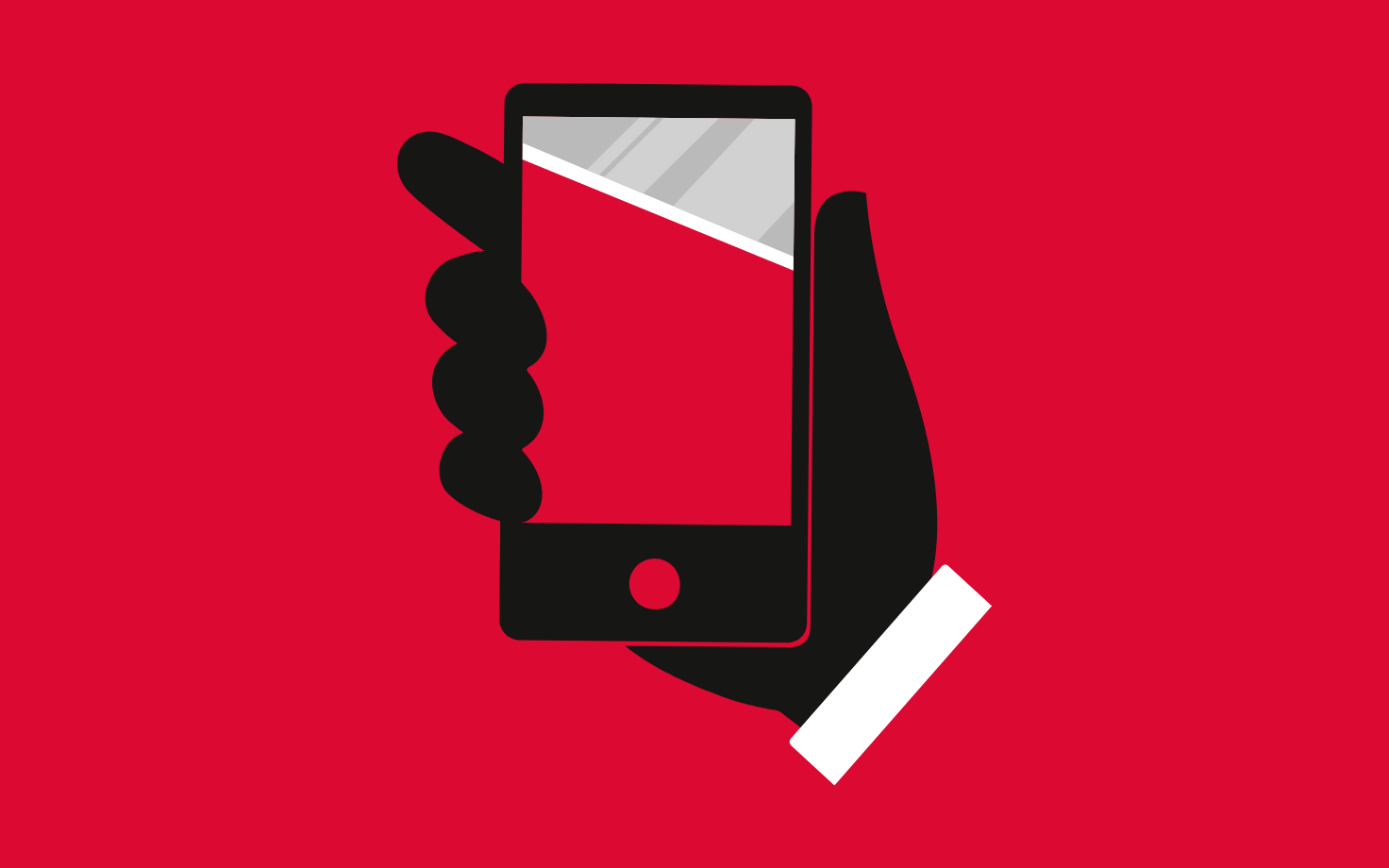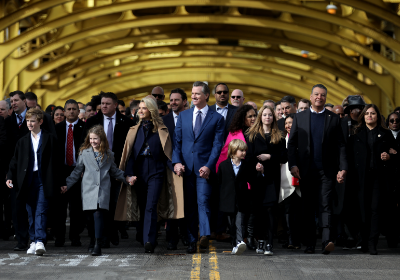POLITICAL EXTREMISM HAS BECOME AN all-too-familiar aspect of American society. From angry tweets penned by politicians to polarizing clips that seem almost satirical, a growing sense of bilateral nationalism is gripping the country. Office holders and candidates pose with guns, use targets in campaign literature, threaten the lives of opponents. Hatred for the other side is becoming not only amplified but normalized.
And anger and extremism are not confined to politics: Hate courses just as thickly through the bloodstream of American media as it does through the rest of the nation’s life. Many readers and viewers choose their news outlets less for information than for ideological reinforcement, idolizing newscasters as they do sports teams.
But which one ignited the fire? Do the media simply shine a light on extremism through their reporting? Or is it possible that the media are actively encouraging extremism, profiting by it and shaping national attitudes toward it? The relationship between mass media and extremism recalls the chicken and the egg. Which begets the other?
Brett McCully, an assistant professor of economics at Collegio Carlo Alberto in Italy, and Jun Luo, a third-year Ph.D. student in the UCLA Communication Studies department, are studying the relationship between hatred and media. Under the UCLA Initiative to Study Hate, McCully and Luo are setting out to explore a question with disturbing implications: Does exposure to partisan media drive radicalization?
Looking for connections
The pair is in its early stages of data collection, meaning that it will be months before the researchers are prepared to report any conclusions. To begin, they have collected the wealth of research that tracks the relationship between mass media and political outcomes. How, for instance, does coverage of candidates and campaigns affect the results of elections?
Many studies have established that connection, demonstrating that the media fuel partisan voting, so it seems natural to wonder whether the media affect other types of political behavior — in this case, extremist behavior. Could it be that coverage helps viewers not only decide how to cast ballots but also whether to engage in violence?
“While it wasn’t like a lightning-bolt moment, I just realized — maybe trying to fall asleep one night — that these topics could really work together,” McCully said. So he and Luo decided to extend their scope into a broader study of cable news channels and extremism. They applied for UCLA’s research initiative.
The team has one mission, at least for now: to understand if the conservative media coax viewers to engage in extremism. They had to find a “natural experiment” that would help them break down cause and effect.
Developing a strategy
To find out how each act of extremism might relate to media viewership, McCully and Luo propose two strategies.
First will be an analysis of the staggered rollout of new right-wing cable channels. Since 2014, channels such as Blaze and Newsmax have come online and begun broadcasting through cable providers. McCully and Luo will contrast hate-crime prevalence in countries with access to these new channels to the prevalence in countries without access across the past several years to see if there is a difference.
Then the researchers will turn to Fox News, employing a novel way of assessing its influence. The notion is that viewers are more likely to tune into a channel with a lower channel number within their cable system. McCully and Luo will divide the nation by counties, separating those that carry Fox News on a low channel position from those that carry it higher on the dial. In theory, those counties with low channel positions for the network will expose more viewers to its contents. The challenge, then, will be to see if those counties also experience higher levels of hatred.
There is already evidence that viewing Fox News affects the behavior of its audience in ways connected to politics. Previous studies have demonstrated, for instance, that Fox News watchers were less likely than viewers of CNN or MSNBC to receive COVID vaccines (studies also have shown, perhaps not coincidentally, that Republicans have died at higher rates than Democrats from COVID). Might a similar effect be at work politically? The research team hypothesizes that viewers who are exposed to right-wing media, including Fox News, will veer further to the right, affecting not only how they view conventional politics, but also inducing extremist behavior as well.
The effects may not be direct, and, of course, the vast majority of Fox News viewers do not resort to hatred or violence. But McCully and Luo are examining the possibility that conservative cable channels serve as a “gateway drug” to the larger far-right ecosystem. The researchers hope to determine whether watching a station such as Fox News may catalyze individuals into exploring more extremist ideology across the Internet and in mass media.
It’s important to note that there is no reason to believe that the effects would be limited to Fox News or conservatives. While initially emphasizing right-wing programming and ideology, McCully and Luo hope to venture into left-wing media as well. They are starting with the right because so much extremist activity is concentrated there. According to the Anti-Defamation League, right-wing extremists are responsible for 75% of extremist-related murders in the last decade.
And of course, it was right-wing extremism that was responsible for the most notorious act of political violence in recent years, the Jan. 6, 2021, insurrection at the U.S. Capitol. “We think it’s important,” McCully added, “to understand the effect of mass media beyond simply its effects on electoral outcomes.”
The team
The pair of researchers knew each other long before joining in this project. Luo was searching for a public policy internship when she stumbled upon McCully in the economics department, working on a broad research project surrounding extremism. After some trial and error, McCully and Luo recognized that mass media would be a compelling angle for their studies and began to tackle the project they’re working on today.
It is a departure for McCully, who specializes in international economics. The matter-of-fact former UCLA Ph.D. student acknowledged that the study of media was new to him, and said he was grateful to be working with Luo, a communications Ph.D. student. For her part, Luo said she finds the methodology of the project tilted toward economics. Playfully describing the project as “communications with a bit of a political science flavor,” the researchers agree that it makes use of both of their talents.
They are collaborating despite geographical separation. Luo works out of Los Angeles while McCully is located in northern Italy. They juggle statistical regressions and preliminary findings, connecting across a nine-hour time difference.
Defining terms
For their ultimate findings to have meaning, the researchers needed to settle on some of the specifics of what they are looking for. It was, for instance, up to the team to define the notion of “hatred,” as well as “extremism.”
“‘Hate’ is such a broad term. And to be honest, it is sometimes hard to measure,” Luo said. “In a new initiative, we also have a group of people discussing the concept itself. There are a lot of different dimensions. You could say it’s an emotion, or it’s an opinion, or it could be just an actual action or a consequential result.”
The research team seeks to measure hatred in three ways: hate crimes, hate groups, and hate actions.
The first subset, hate crimes, will be measured by analyzing local police reports submitted to the FBI. These are compiled into Uniform Crime Reports and aggregated at the county level. McCully and Luo are focusing on counts of hate crimes in specific geographic areas as opposed to investigating individual events.
Regarding hate groups, the researchers will rely on the work of the Southern Poverty Law Center, a nonprofit organization that monitors extremists throughout the United States. Using groups identified by the center as known purveyors of hatred, the researchers will match the selected hate groups to their respective counties; this will guide the team in drawing conclusions about the geographic spread of hate groups and their relationship to media exposure.
Lastly, there are hate actions. Again, Luo and McCully intend to build on the work of others, in this case the Anti-Defamation League. The league catalogs hate actions — not all of them crimes — and that database will provide the core of the material that Luo and McCully rely upon. If an individual partakes in antisemitic leafleting through a hate group, for instance, his or her actions would be reported to the Anti-Defamation League and thus qualify as a hate action, McCully said, even though that activity would likely not constitute a hate crime.
Using Nielsen ratings
To couple their findings of extremism with media viewership, McCully and Luo observe data from Nielsen Media. This database shares information on audience viewership. Particularly useful for this project, it highlights different accounts of how many people are watching right-wing cable television and where.
Comparing viewership numbers to hate crimes, groups or actions may yield intriguing leads, but connecting the two — demonstrating that watching a particular network actually leads a viewer to engage in hatred — is a more difficult proposition.
To better grasp the causal relationship, McCully lays out an example. There could be high Fox News viewership in a city where several hate crimes have been recorded. But the crimes may be attributable to other factors — a history of local racism, a recent incident that inflamed tensions. This might drive people to prefer Fox News rather than to be motivated by it, inverting the causal connection between hatred and viewership. So the research team intends to look at exposure to Fox News that is unrelated to those other potential causes or factors that might be driving hate crimes.
“For that, we follow other researchers who’ve already looked at the effects of Fox News on voting outcomes. If Fox News Channel is channel No. 1 on your cable system, then that should lead to a lot more viewership than if the channel number of Fox News is 2000,” McCully said. The channel position works as a tool to ensure that the researchers are underscoring the “true” impact of watching Fox News on extremism.
Making sense of the data
Once the data is in hand, it will be up to the researchers to make sense of it. The goal, McCully and Luo said, is to go beyond presenting the shows and networks favored by hateful people and instead be able to point to the media messages that may encourage that hatred. The actual numbers of people so affected may be very small, they cautioned, but small numbers can nevertheless account for a great deal of violence and intimidation.
”Extremist activity tends to be very rare in the population,” McCully said. “So if it’s happening for even a sliver of people, given how many millions watch these channels … that would still be socially and politically salient.”
The pervasiveness of mass media is often taken for granted. McCully and Luo hope that by studying its relationship to extremism, researchers may better understand not just the ubiquity of media but its power as well — in this case, its power to inflame and encourage hatred.





















